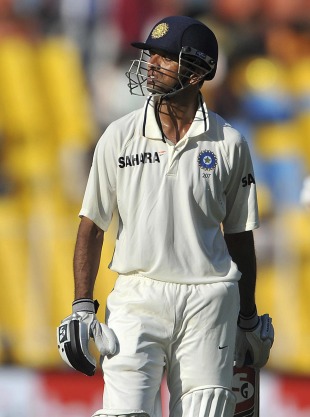
| |||
| | |||
Watching his innings of two halves in Ahmedabad prompted the question: is Dravid too aware of his own mortality?
By playing with a bat Michael Hussey called "three metres wide", and doing so in his 38th year, Sachin Tendulkar doesn't only continue to give people a hard time, he gives hope to many others that if you stay around long enough, a second wind is possible. Of course it assumes that you will be picked in that period - some teams cull ruthlessly while others enforce temporary bans - and be fit enough to scour the horizon for that second coming.
I thought of that as I watched Rahul Dravid struggle his way through his first hundred balls in Ahmedabad. My mind, so full of admiration for a great cricketer, was willing him on, but younger, more irreverent, observers on my Twitter feed were calling for his head. Apart from a little purple patch in 2009, Dravid has been averaging in the thirties over three years (interestingly these numbers are very similar to those Tendulkar generated during his lean phase in the middle of this decade) and didn't always look like the great player he is.
Surely on a cruelly flat deck and against an attack that wasn't likely to scare a top team, he could have batted like the player we knew, or indeed like the player we saw after the shackles he had imposed on himself were broken and a century appeared. Or was it that Dravid was building bunkers around him, creating defences against every possible dismissal? Was he getting so caught up with survival that not getting out would seem a success?
A couple of days earlier I heard Sourav Ganguly say, on a news channel, that as a player moves past the mid-thirties he loses his confidence far more than he does his ability. And I wondered if that was the case with Dravid, surrounded as he is by young batsmen, who admire him but challenge him nonetheless. Was he so increasingly aware of his mortality, I wondered, that he was guarding himself against every possibility?
Sometimes players, like managers, can analyse in such detail that they end up thinking of weaknesses that may or may not exist. Batsmen can start preparing for every possible way in which they can get out. As patients get older, they worry about infections cropping up from just about anywhere, where in younger days they might have drunk water out of a tap at a railway station, or jumped out of a tree oblivious to injury. Batsmen can therefore start focusing too much on not getting out rather than on scoring runs.
Indeed, watching cricket in that phase you couldn't help thinking that one player, Virender Sehwag, was looking for an opportunity to score, while another, Dravid, was searching for safety. One seemed to enjoy being out in the middle, like a kid might on a rollercoaster, while the other was gritting his teeth like he was preparing for an assignment on the implications of Bernoulli's Principle. (And given that the passage of a ball through air tends to be governed by the work of the aforementioned gentleman, he probably wasn't too far away anyway!)
Having said that, Dravid could well counter the point saying that he has addressed every match the same way in the last 14 years, and has an extraordinary body of work to support his thesis; that on another day Sehwag might look flippant and the gravitas that Dravid exudes might be more reassuring; that being a man of erudition, a deep thinker and an analyst, has always worked for him.
As it turned out, a century duly arrived, one that took him past Bradman's 29 - once considered as unattainable as a four-minute mile was - at a strike rate better than that achieved over his career. The second half of his innings, in terms of balls faced, produced 80% of his runs. The certainty that Dravid exuded through a glittering career was back, the feet had started to glide, and the bat was searching for runs where it had been intent on guarding the wicket.
Did the confidence that Ganguly was talking about return? Did a voice tell him that putting money in a locker was not much good in a bull market? And will this century, and the accompanying confidence, lead to the second wind, the kind Tendulkar has shown?
I do not know. But what I do know is that beyond a point, the more you analyse, the more you budget for failure. Now that may be good for Obama's security entourage but not necessarily so for quality cricketers.








0 comments:
Post a Comment